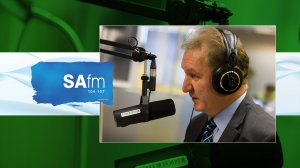Every Friday morning, SAfm’s AMLive’s radio anchor Sakina Kamwendo speaks to Martin Creamer, publishing editor of Engineering News and Mining Weekly. Reported here is this Friday’s At the Coalface transcript:
Kamwendo: Botswana taking steps to export electricity to South Africa.
Creamer: It was very interesting being in Botswana this week and listening to all the people coming over about how they have got so much coal in Botswana and how they are looking very intently at the advert that has come from South Africa that South Africa want 3 700 MW of power from IPPs across border.
IPPs are really moving to meet that demand. Several of the companies came up and said that they have got the coal, but they have done the calculations and to actually build railway lines now is going to be uneconomic. They are thinking of going through to Namibia to export and also Richards Bay. Their lowish grade coal they said the ideal way to deal with it now is not to build railway lines, but to send it along existing transmission lines, electrons going along to our South Africa in the form of electricity.
So, let’s turn that coal into electricity, let’s respond now to this request from South Africa for power from us and get going and also strengthen the electrical bond. They are very keen on the tenders that have come out that is called Bosa, Botswana South Africa and it is increasing the capacity to deal with the electricity from a sub-station point of view and infrastructure point of view.
Kamwendo: There is a new way of mining and this has the potential to make mining safer and more productive.
Creamer: Can you believe it is foam injections. We used to drilling and blasting and that shakes up the place and actually makes it unsafe. What they want to do now is use a mixture of water, air and can you believe it, soapy water. They seal that create a pressure and it works very well. You can actually continually mine, so you don’t have to leave the mine as you do when you blast because it is unsafe to be there.
You can be there 24 hours a day 365 days a year using this foam injection, soapy water going in there under pressure blasting rock and actually removing it in large slices. We have seen so much development going on in trying to cut the rock using new equipment that is all expensive and capital intensive.
Even the operational part of it is intensive. Now, coming up with this much simpler version and they say they will also mechanise this. It won’t just be hand held situation, it will be a mechanised situation. They believe it could extend the life of our hard rock mines. We have got the narrow-reef hard rock mines under here and a lot of them have had to cease operating because of cost reasons.
You can go back in there and use this method which is much safer and much more productive, because you can go round the clock. At the existing methods you are using about 25% of your time, because you have to get out of the mine, this would mean you can just continue. There is no big loud noise, no dust and no toxicity. They are very keen and this has come through from veteran researcher Rod Pickering, who has spent 40 years studying this.
Kamwendo: Mining has been given a boost with the reopening of Joburg’s once world-renowned Research Organisation.
Creamer: You go to Canada or Australia and you will find that the way they do ventilation their design and rock breaking techniques have come from South Africa. We have lost all that expertise for a while, because we had that very fantastic Comro, it is called the Chamber of Mines Research Organisation, down in Carlow Road, down the road from where we are sitting here.
But, that was handed over to the State, to CSIR. It became very underfunded and started stuttering along. Now we have had the Mining Phakisa and 120 people have sat there for five weeks and started to work out how the mining can again be an engine for growth. They have come out that the heart of this has got to start with this Comro.
That has been reopened and it already starting to buzz. This time it is not going to be State owned separately or private-sector owned. It is going to be a public private partnership, both of them getting together. Already the funding there is starting to step up thanks to the Department of Science and Technology. They are looking for quick wins, but we are back in the research and development game in mining in South Africa.
Kamwendo: Thanks very much. Martin Creamer is publishing editor of Engineering News and Mining Weekly.
Edited by: Creamer Media Reporter
EMAIL THIS ARTICLE SAVE THIS ARTICLE
To subscribe email subscriptions@creamermedia.co.za or click here
To advertise email advertising@creamermedia.co.za or click here












